Caroline Herschel, Co-Discoverer of the Universe – Ancient Origins
Caroline Herschel is famous for being one of the first women to make significant contributions to astronomy. She discovered eight comets and many nebulae and star clusters, both on her own and in accomplice with her brother William Herschel.
For this reason, she has become an inspiration for many women in science. She also played a major role, along with her brother, in shaping the modern view of the cosmos with her recording of nebulae, many of which turned out to be galaxies.
Caroline Herschel’s Early Life
was born Karoline Lucretia Herschel on March 16, 1750 in Hannover in modern-day Germany. At the time, Hannover was under the control of the British king, making her a British subject despite German being her birth language. She was one of 10 children.
Although Caroline’s parents were well off, her childhood could have been better. At the age of about 10, she contracted typhus which stunted her growth. She never grew taller than four feet and three inches. She also caught smallpox at the age of three which had left her disfigured.
Her parents did not believe that she would amount to much. She showed an early interest in astronomy, but her mother disapproved of her education and trained her for housework.
The Beginning of Caroline Herschel’s Astronomical Career
In 1772, when Caroline was 22, her brother William Herschel invited her to live with him in Bath, England where he had found a job as a music instructor. William, who was born in 1738, had always been gifted in music and had written several symphonies. In Bath, England, Caroline also received music lessons and learned to sing.
She and William ended up giving several music performances together while living in the town. William also had a keen interest in astronomy which helped to further enchant his younger sister Caroline with her life-long interest in the heavens.
In the meantime, William’s interest in astronomy was growing. He had made his own telescope which he used to observe the skies from his home in Bath. When Caroline came to live with him, he made her his assistant. She would polish and grind mirrors and record observations which he would shout down he as peered through the telescope on long nights over the years.
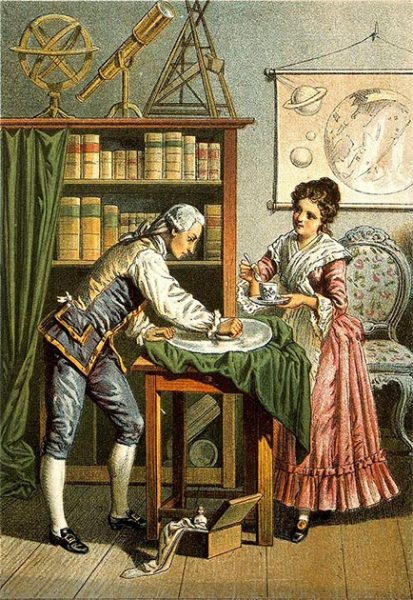
William and Caroline Herschel polishing a telescope mirror. (GreenMeansGo / )
In 1781, William Herschel , becoming the first person in the Western tradition to officially discover a new planet since antiquity. This immediately made him famous and King George III invited him to serve as court astronomer in 1782. For this position, Herschel would be paid a generous salary of 200 pounds per year which he could use to fund his astronomical research.
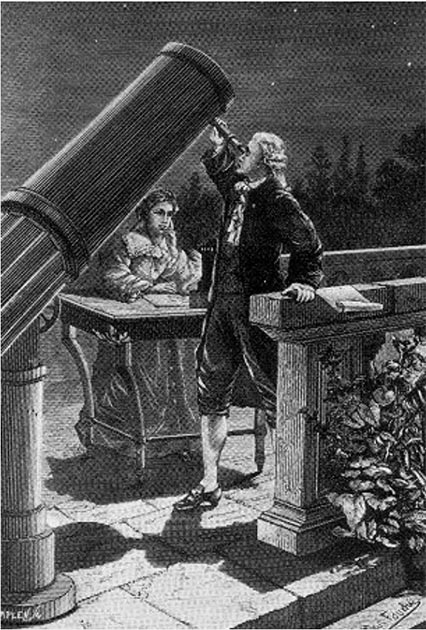
Caroline Herschel taking notes as her brother William observes on March 13, 1781, the night William discovered Uranus. (H.Seldon / )
William and his sister could not turn down this opportunity and they moved out of the town of Bath to a village in rural England near Windsor. While there, Caroline and William began their joint observations in earnest of nebulae, star clusters, and eventually comets. Caroline continued to help him with observations.
Caroline, however, does not appear to have found country life to her liking. William, to cheer her up and keep her occupied, made her several telescopes, one of which was a Newtonian reflector, to make her own observations. It is after this that her observations began in earnest.
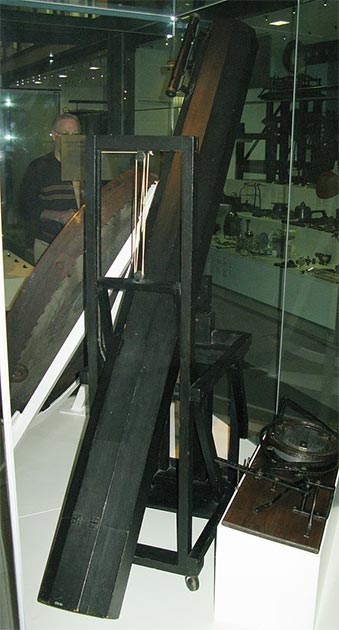
A telescope that William made for Caroline Herschel. (Geni / )
Over the next several decades, both on her own and working with William, she would discover eight comets and record many nebulae. In 1787, she even began to receive a salary for her work as an assistant to William of 50 pounds per year, becoming the first woman to receive a salary as a scientist. Although she was officially William Herschel’s assistant, at least until his death in 1822, she also made many observations on her own and became increasingly independent.
The Comet Discoveries of Caroline Herschel
Until the late 20th century, Caroline Herschel held the record of being the woman to have discovered the most comets. The first comet that she officially discovered was one that she found while scanning the skies in 1786.
This comet now bears her name, C/1786 P1 (Herschel). She first identified the comet on August 1, 1786, though she did not know what it was yet. The following night she confirmed it with further telescopic observations. Several weeks later, a naked eye observation of the comet was made on August 17th.
The second comet she discovered is also famous, 35P/Herschel-Rigollet. She discovered it on December 21, 1788 and compared notes with her brother. It had a brightness magnitude of about 7.5. They continued to track the comet until February 5, 1789.
This comet would make another appearance in history. Over 150 years later, in July 1939, a Frenchman, Roger Rigollet, identified a comet which was tracked until January 1940, when it was last observed by the Lick Observatory. The astronomer L. E. Cunningham computed the orbit of the comet and concluded that it must be the same comet that was observed by Caroline Herschel back in 1788.
Another famous comet that she discovered was the comet 2P/ Encke. The comet Encke was first observed on January 17, 1786 by Pierre Mechain, a well-known comet hunter.
The object was not observed again until almost 10 years later by Herschel on November 7, 1795. After Caroline Herschel’s observation, it was encountered again in 1805, though at this point astronomers didn’t know that it was the same comet.
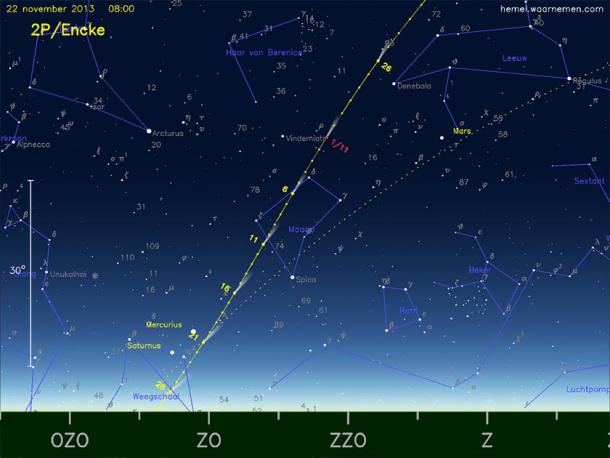
Caroline Herschel observed comet 2P/Encke. (AstroFloyd / )
In 1818, another comet was found and the German astronomer and eventual director of the Berlin Observatory, Johann Encke, calculated the orbit of the comet and determined that it must be the same comet which had appeared in 1786, 1795, and 1805, though he was not the first to suggest it.
He also predicted the return of the comet in 1822. For this reason, the comet was named after Encke since he predicted the comet’s return in the same way that Halley’s comet was named after Edmund Halley when he predicted its return.
The story of 2P/ Encke continues into the space age. In 2013, it was observed up close by the MESSENGER spacecraft as well as the STEREO spacecraft. The comet is known to have a diameter of about 3 miles (4.8 kilometers) and an orbital period of 3.3 years. It is also known for having a very short orbital period compared to other known comets in the solar system.
The last comet that Herschel discovered was comet C/1797 P1 (Bouvard-Herschel) which she and another astronomer, Eugene Bouvard, discovered independently on the same night of August 14, 1797. This comet came very close to Earth, coming within only 0.0879 A.U. (Astronomical Unit, distance between Earth and the Sun) on August 16th.
Caroline Herschel and the New General Catalogue
C/1797 P1 (Bouvard Herschel) was the last comet that Herschel is credited with discovering. She also made discoveries of several important nebulae, expanding what eventually would become the New General Catalogue (NGC). The New General Catalogue is a catalog of nebulae, galaxies, star clusters and other deep space objects that Caroline and William Herschel began recording by the 1780s.
By the early 19th century, William and Caroline had recorded over 2,500 objects. This was continued by Caroline Herschel’s nephew, John Herschel , who recorded thousands more from his observatory in South Africa. The NGC catalogue is one of the most extensive catalogues used in modern astronomy.
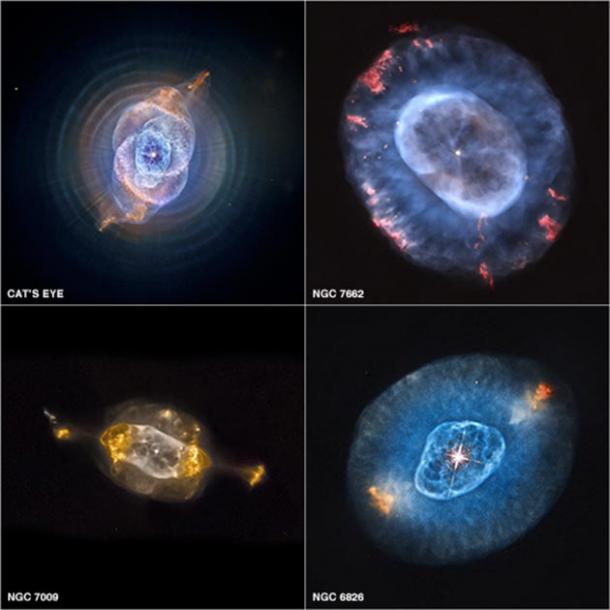
Four different planetary nebulae from the NGC catalogue. (Jcpag2012 / )
Among the nebulae that Caroline Herschel helped to record, two that she is famous for are NGC 2360 and NGC 205. NGC 2360 is a star cluster that Caroline Herschel discovered on February 26, 1783. It is significant in being the first deep sky object that she discovered in her own right.
NGC 2360 is now known to be an open star cluster that is about 6,150 light years from Earth and has a magnitude of 7.2. From the perspective of our solar system, it is located in the constellation Canis Major.
Open star clusters are composed of stars that are loosely bound to each other by mutual gravitational attraction. They are believed to originate most often from clouds of interstellar gas and dust within the arms of spiral galaxies.
Open star clusters are principle star forming regions and all stars in our galaxy and in other galaxies are believed to likely have their origin in an open star cluster. Caroline Herschel’s discovery eventually helped lead to an understanding of how the stellar population in galaxies evolves over time.
Another object that Caroline Herschel is famous for discovering is NGC 205. NGC 205 was first observed on August 10, 1773 by Charles Messier, but Messier, for whatever reason, failed to put it in his catalogue. It was discovered again by Caroline Herschel on August 27, 1783 and William Herschel added it to his catalogue on October 5, 1784. It was finally added to the Messier catalogue in 1966 by Kenneth Glyn Jones as Messier 110 or M110.
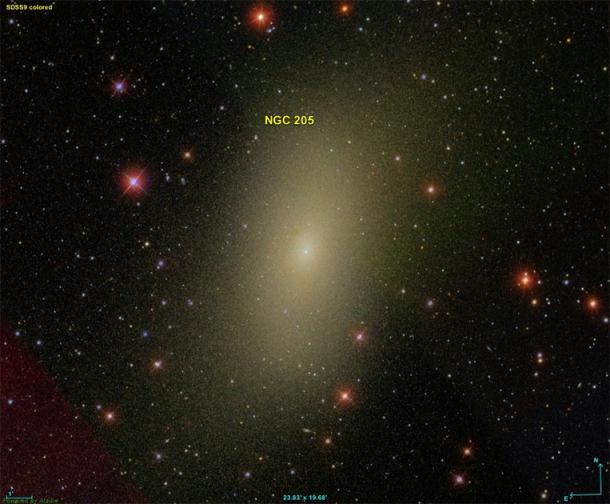
Caroline Herschel observed Messier 110 in 1783. ( / CC BY-Sa 4.0)
NGC 205 is significant as a satellite galaxy to the Andromeda Galaxy which is the closest large galaxy to the Milky Way. NGC 205, as a result, is about the same distance from the Milky Way, 2.9 million light years. It is now known to be an elliptical or dwarf spheroidal galaxy.
As a spheroidal galaxy, it consists of old stars and relatively little gas and dust. These spheroidal galaxies are apparently very useful for doing X-ray astronomy because the stellar bodies are far apart from each other and there is relatively little gas and dust to absorb the X-rays and re-emit them at longer wavelengths.
Caroline Herschel’s Role in Discovering the Universe
Caroline Herschel along with their brother observed many objects, which they referred to as nebulae, which later turned out to be very significant cosmic objects. In the late 18th century, not much was known about the structure of the universe. Astronomers had only discovered that Earth was not the center of the universe a few centuries earlier.
The discoveries that Caroline Herschel and her brother William Herschel made paved the way for a modern understanding of the universe. Astronomers later discovered that many of the nebulae that the Herschel siblings found were galaxies.
Up until the early 20th century, astronomers and cosmologists believed that our galaxy was the only galaxy and that these nebular structures were within our galaxy. The astronomer Edwin Hubble showed that spiral nebulae, at least, must be other galaxies and that our galaxy was only one among many other galaxies.
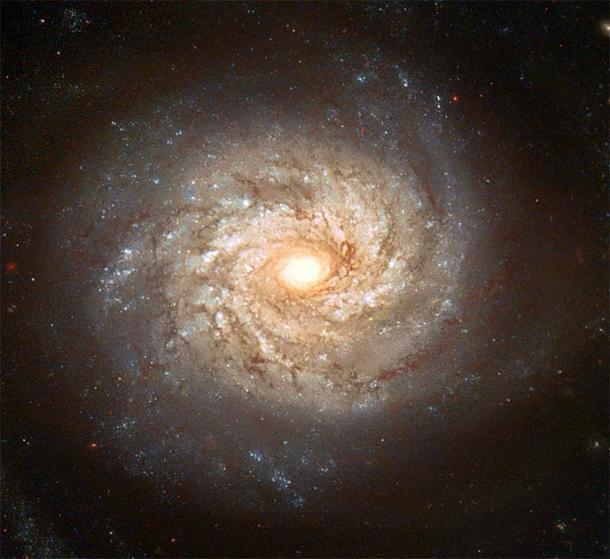
Spiral Galaxy NGC 3982 displays numerous spiral arms filled with bright stars, blue star clusters, and dark dust lanes. (BevinKacon / )
Once astronomers knew that these mysterious cosmic objects were other galaxies, they also determined that most galaxies were redshifted, that is, their light was shifted to the red end of the electromagnetic spectrum. Edwin Hubble also played a major role in the discovery that “redshifted” galaxies were in fact moving away from us, supporting the idea that the universe was expanding.
The universe is not static but changes and evolves. We now know that galaxies themselves also evolve and change over billion-year timescales as stars are born, live, and die within them. This revolution in modern cosmology largely began with the humble observations of nebulae initiated by Caroline Herschel and her brother.
William Herschel passed away in 1822. After his death, Caroline Herschel decided to leave England and go back to Hannover. While in Hannover, she continued her recording of nebulae and star clusters. During her final years, she enjoyed fame as a woman scientist.
It was very unusual for a woman to make major accomplishments in science, let alone receive a salary as a scientist, at the time. As a result, she was somewhat of a celebrity. Her accomplishments were also recognized.
She received a medal from the Astronomical Society for her scientific work in 1828. By the time of her death in 1848, she was well respected within the scientific community. Her scientific accomplishments have helped to shape modern astronomy and cosmology.
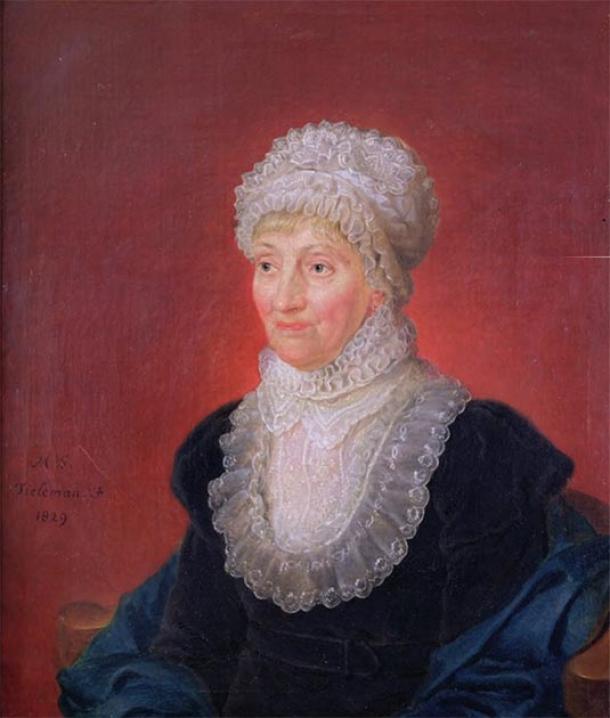
Caroline Herschel at 78, one year after winning the Gold Medal of the Royal Astronomical Society in 1828. (Bernd Schwabe in Hannover / )
Her role as a woman scientist also helped to empower women which is why she is a feminist icon today. She has been an inspiration to both female and male scientists around the world ever since.
Top image: Caroline Herschel’s interest in astronomy led her to be the co-discoverer of the universe. Source: / Adobe Stock.
By Caleb Strom
References
Brooklyn Museum. Date Unknown. Caroline Herschel . [Online] Available at:
Bryant, G. 1997. The Comets of Caroline Herschel. [Online] Available at
Editors of Encyclopaedia Britannica. 2019. Andromeda Galaxy . [Online] Available at:
Editors of Encyclopaedia Britannica. 2020. Caroline Herschel . [Online] Available at:
Frommert, H., and Kronberg, C. 2013. Messier 110 . [Online] Available at:
Frommert, H., and Kronberg, C. 2009. NGC 2360 . [Online] Available at:
Frommert, H., and Kronberg, C. 2007. Star Clusters . [Online] Available at:
Gallagher, J., and Wyse, R. 1994. Dwarf Spheroidal Galaxies: Keystones of Galaxy Evolution . [Online] Available at:
Goldstein, A. 2018. An NGC primer . [Online] Available at:
Hunt-Walker, N. Date Unknown. What should we know about dwarf galaxies? . [Online] Available at:
NASA Solar System Exploration. 2019. 2P/Encke. [Online] Available at:
Olson, R., and Pasachoff, J. 2012. The Comets of Caroline Herschel (1750-1848), Sleuth of the Skies at Slough . [Online] Available at:
Petersen, C. 2019. Meet William Herschel: Astronomer and Musician . [Online] Available at:
Redd, N. 2012. Caroline Herschel Biography . [Online] Available at:
Smith, R. 2019. Edwin Hubble . [Online] Available at:






